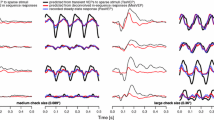Abstract
Visual pattern reversal evoked potentials constitute a test that can reveal early pathological changes in multiple sclerosis Sixty nine subjects (52 controls, and 17 patients) were studied with this technique.
The transient potentials evoked by checkerboard pattern reversal reveal an increase in the CII peak latency (significantly different from the controls) in M.S., with single elements of 15 and 30 min of arc and 20%–50% of contrast depth.
The steady state potentials are absent or show phase lags in some patients with transient responses within the normal limits.
The delayed evoked responses are detectable in a high percentage of patients with M.S., even when ocular symptoms are not seen in the clinical observation.
Transient and steady-state E.Ps can furnish early tools for evaluation of funcionality of visual pathways related to retinal form- and movement-analyzers, the former being sensitive to high spatial frequencies but conducting more slowly than the latter.
Sommario
I potenziali evocati visivi costituiscono un test di notevole interesse nella diagnosi precoce della sclerosi multipla. Sulla base di precedenti lavori, 69 soggetti (52 sani e 17 affetti da S.M.) sono stati studiati con questa tecnica.
La risposta transiente da stimolazione con scacchi in pattern reversal ha rilevato un incremento della latenza di CII (significativamente differente dai controlli) nella S.M. con elementi di 15 e di 30 min di arco e con contrasti di 20 e 50%.
Le risposte steady-state sono risultate assenti o con alterazione di fase in molti pazienti ove la risposta transiente era nei limiti.
Tali risposte alterate sono state registrate in un'alta percentuale di pazienti con S.M., anche quando i segni oculari non erano presenti all'osservazione clinica.
Le risposte transienti e steady-state possono pertanto fornire utili indicazioni sulla funzionalità delle vie visive correlate con gli elementi percettivi di forma e di movimento. I primi risultano più sensibili alle alte frequenze spaziali ma con una conducibilità più lenta rispetto ai secondi.
Similar content being viewed by others
References
Arden G. B., Faulkner D. J., Mair C.:A versatile television pattern generator for visual evoked potentials. In: Desmedt J. E. (ed.),Visual evoked potentials in man: new developments. Clarendon Press Oxford, 90–110, 1977.
Duwaer A. L., Spekeijse H.:Latency of luminance and contrast evoked potentials in multiple sclerosia. EEG and clin. Neurophysiol., 45: 244–259, 1978.
Gambi D., Rossini P. M., Sollazzo D., Albertini G.:Le risposte evocate visive sotto stimolazione a diversa lunghezza d'onda nella diagnosi precoce della sclerosi a placche. Riv. Ital. EEG e Neurofisiol., 1: 321–327, 1978.
Gambi D., Rossini P. M., Onofri M.:Valore delle tecniche di stimolazione ripetitiva nella genesi del potenziale evocato visivo «steady state». Atti del IV corso di aggiornamento di neurooftalmologia. Soc. Ital. di Neurologia, Bologna, 27 ottobre, 1978.
Gambi D., Rossini P. M., Onofri M., Colangelo U., Aquilone L.:Risposte evocate da pattern reversal nella sclerosi multipla. Riv. Ital. EEG e Neurofisiol., 11, 1: 147–152, 1979.
Gambi D., Rossini P. M., Onofri M., Di Giovanni T., Marchionno L.:Il VEP da pattern reversal: analisi della risposta a stimoli di frequenza temporale e spaziale, in soggetti normali e affetti da sclerosi multipla. Riv. Ital. EEG e Neurofisiol. (in press).
Halliday A. M., Mc Donald W. J., Mushin J.:Visual Evoked Response in the diagnosis of multiple sclerosis. Br. Med. J., 4: 661, 1973.
Jeffreys D. A.:Component analysis of the spatial contrast. EP. Trace, 6: 30, 1972.
Jones R., Keck M. J.:Visual evoked response as a function of grating spatial frequency. Invest. ophthal. visual. Sci., 17: 652–659, 1978.
Lumsden C. E.:The neuropathology of multiple sclerosis. In P. J. Vinken and G. W. Bruyn (eds), Handbook of Clinical Neurology, vol. 9, Elsevier, Amsterdam, 217, 1970.
Mc Alpine D.:The benign form of multiple sclerosis: results of a long-term study. Br. Med. J., 2: 1029, 1964.
Mc Alpine D., Lumsden C. E., Acheson E. D.:Multiple sclerosis: a reappraisal. Churchill-Livingstone, Edinburgh, 1972.
Regan D., Milner B. A., Heron J. R.:Slowing of visual signals in multiple sclerosis, measured psychophysically and by steady-state evoked potentials. In Desmedt J. E., (ed.),Visual evoked potentials in man: new developments; Clarendon Press Oxford, 461–469, 1977.
Richey E. T., Kooi K. A., Tourtellotte W. W.:Visually evoked responses in multiple sclerosis. J. Neurol. Neurosurg. Psychiat., 34: 275, 1971.
Author information
Authors and Affiliations
Rights and permissions
About this article
Cite this article
Gambi, D., Rossini, P.M., Onofri, M. et al. Visual evoked cortical potentials (V.E.C.P.) by television presentation of different patterned stimuli to patients with multiple sclerosis. Ital J Neuro Sci 1, 101–106 (1979). https://doi.org/10.1007/BF02336851
Issue Date:
DOI: https://doi.org/10.1007/BF02336851




